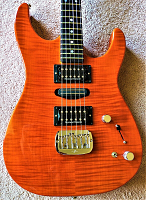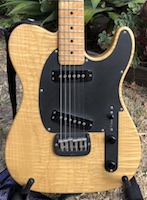I was just wondering how you guys deal with the tapered post when stringing a G&L. I understand the reason, to bring the string down closer to the headstock, achieving the best break angle of the string over the nut, but I tend to struggle a little when wrapping. I noticed last year on my new G&L that the factory only uses one wrap, but when I tried that, I ruined a high E as it somehow slipped through.
Do you guys use one wrap, or have a particular method that you use to keep multiple wraps from overlapping?
JT
Re-stringing G&L guitars
-
guitar1580
- Posts: 75
- Joined: Wed Oct 15, 2014 9:54 pm
- Location: West Virginia
-
Craig

- Site Admin
- Posts: 11561
- Joined: Tue Mar 03, 2009 10:52 am
- Location: Either Coto De Caza, CA or Paso Robles, CA
Re: Re-stringing G&L guitars
See this post in our G&L Knowledgebase for some suggestions: G&L Vintage tuners make me swear and throw things!.guitar1580 wrote:I was just wondering how you guys deal with the tapered post when stringing a G&L. I understand the reason, to bring the string down closer to the headstock, achieving the best break angle of the string over the nut, but I tend to struggle a little when wrapping. I noticed last year on my new G&L that the factory only uses one wrap, but when I tried that, I ruined a high E as it somehow slipped through.
Do you guys use one wrap, or have a particular method that you use to keep multiple wraps from overlapping?
JT
Also try using the Search feature to see any other posts on this subject.
Hope this helps.
--Craig [co-webmaster of guitarsbyleo.com, since Oct. 16, 2000]
Welcome! Read This First
Got a G&L question? Check out the: G&L Knowledgebase
Current G&L Specifications and Options
Welcome! Read This First
Got a G&L question? Check out the: G&L Knowledgebase
Current G&L Specifications and Options
-
Al Evans
- Posts: 40
- Joined: Fri Mar 25, 2016 2:01 pm
Re: Re-stringing G&L guitars
Replacing them with locking tuners works for me.guitar1580 wrote:I was just wondering how you guys deal with the tapered post when stringing a G&L. [...]
JT
--Al Evans
-
guitar1580
- Posts: 75
- Joined: Wed Oct 15, 2014 9:54 pm
- Location: West Virginia
Re: Re-stringing G&L guitars
The problem with locking tuners is that they don't all position your string at the bottom of the post, giving the optimum break angle over the nut. This is most important on the G and D, where there is no string tree. Locking tuner users may want to add a tree there. Actually, a while back when I put Sperzels on my older Strat, I got them to exchange my D & G for another E & B, just for that reason.
I read the other threads, and I'm pretty much doing those things. I guess it's just going to be one of those "nature of the beast" things where you have to wrestle with the B and high E a little. I may even try the method I use on my Martins, of bringing the tail around and hooking it under itself, for the high E, instead of putting it in the center hole.
I noticed that my Tribute doesn't have the tapered posts like my USA models.
JT
I read the other threads, and I'm pretty much doing those things. I guess it's just going to be one of those "nature of the beast" things where you have to wrestle with the B and high E a little. I may even try the method I use on my Martins, of bringing the tail around and hooking it under itself, for the high E, instead of putting it in the center hole.
I noticed that my Tribute doesn't have the tapered posts like my USA models.
JT
-
tdiers

- Posts: 84
- Joined: Fri Sep 28, 2012 3:13 am
- Location: Okinawa, Japan
Re: Re-stringing G&L guitars
That might be why Fender & G&L went with staggered tuners (i.e. Schaller Staggered Locking Tuners). It allows for a steeper angle on the further away tuners without needing string trees. However, I've seen them with trees also.


2025 BTO Legacy Special in Honeyburst swamp ash
2022 Legacy Special, Cherryburst, Saddlelock
2021 BTO Legacy HSS RMC, Greenburst Frost, Black Headstock
2016 Legacy, 3-Tone Burst
2007 Invader Plus Deluxe HSH RMC, Clear Orange Flame Maple, Saddlelock
2022 Legacy Special, Cherryburst, Saddlelock
2021 BTO Legacy HSS RMC, Greenburst Frost, Black Headstock
2016 Legacy, 3-Tone Burst
2007 Invader Plus Deluxe HSH RMC, Clear Orange Flame Maple, Saddlelock
-
cho

- Posts: 202
- Joined: Tue May 26, 2015 9:53 am
- Location: Los Angeles area
Re: Re-stringing G&L guitars
I've been using this method for 35 years, with no problems:
http://gordwait.blogspot.com/2014/01/th ... lling.html
http://gordwait.blogspot.com/2014/01/th ... lling.html
-
guitar1580
- Posts: 75
- Joined: Wed Oct 15, 2014 9:54 pm
- Location: West Virginia
Re: Re-stringing G&L guitars
Cho, I use a variation of the method you've shown, and also have not had any problems on that style of tuner. The only issue I have with the method shown is that it does not bring the string down to the bottom of the post to give maximum break angle over the nut. The tapered G&L tuner post is designed to do just that - force the string to the bottom, so it is desirable to do that.
I do use the "reverse wrap" technique you show, but I allow enough string to do several wraps around the post in order to get the string down low on the post. Obviously, the smaller the string, the more wraps you get. I'm always careful to get the wraps neatly under the previous one, so as not to have them overlapping, which would allow for the wraps to compress on each other, causing the string to go out of tune. The G&L tapered tuners require a little more effort to keep the wraps going under one another before the string slips to the bottom of the post, which is what my original question was about.
On the A and low E, I do one wrap above the hole and a couple more under the hole to get the maximum break angle, as the "reverse wrap" gets a little bulky with larger diameter strings. I've used this method on my Martin acoustics for years, and after the strings are stretched and seated, they rarely ever go out of tune.
Thanks for sharing.
JT
I do use the "reverse wrap" technique you show, but I allow enough string to do several wraps around the post in order to get the string down low on the post. Obviously, the smaller the string, the more wraps you get. I'm always careful to get the wraps neatly under the previous one, so as not to have them overlapping, which would allow for the wraps to compress on each other, causing the string to go out of tune. The G&L tapered tuners require a little more effort to keep the wraps going under one another before the string slips to the bottom of the post, which is what my original question was about.
On the A and low E, I do one wrap above the hole and a couple more under the hole to get the maximum break angle, as the "reverse wrap" gets a little bulky with larger diameter strings. I've used this method on my Martin acoustics for years, and after the strings are stretched and seated, they rarely ever go out of tune.
Thanks for sharing.
JT